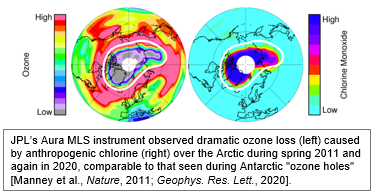Stratosphere And Upper Troposphere

Our group, which includes members of the JPL science team for the Aura Microwave Limb Sounder (MLS) project, provides scientific leadership in conceiving, developing, implementing, and analyzing remote sensing composition measurements to better characterize Earth’s atmosphere and climate.
Key science questions our group is focused on addressing include:
- How are upper tropospheric and stratospheric (UT/S) water vapor and ozone and associated chemical and dynamical processes evolving in a climate with increasing greenhouse gases and changing ozone-depleting substances?
- Given their strong radiative impact, how do changes in UT/S water vapor and ozone feed back on climate?
- What are the relative roles of various stratosphere-troposphere exchange mechanisms (e.g., deep convection, monsoon circulations, intrusion events) in establishing the composition and humidity of the UT/S? What drives the variability in these processes and their impacts on the UT/S, and hence climate, the middle and lower troposphere, and ultimately air quality and human/ecosystem health?
Stratosphere And Upper Troposphere: Missions and Projects
The scientific expertise and research activities of the group members include:
- Theory and practice of remote sounding of the Earth's atmosphere from satellite platforms.
- Development, implementation, and validation of operational algorithms for forward modeling of atmospheric radiances and inverse modeling for retrieval from space-borne observations of geophysical data products, including temperature, composition, and cloud ice water content.
- Production and homogenization of long-term upper tropospheric, stratospheric, and mesospheric data records from current and past measurements.
- Assessment of the performance of global chemistry climate models through comparisons of simulated fields with long-term observational datasets.
- Climate variability and climate change.
- Water vapor, clouds, and aerosol interactions and their climate feedbacks.
- Tropical convection and interaction with large-scale dynamics.
- Cloud resolving modeling and mesoscale modeling.
- Processes controlling trace gas distributions in the upper troposphere / lower stratosphere (UTLS), such as the convective transport of boundary-layer pollutants and stratosphere-troposphere exchange.
- The impact of the summer monsoons on UTLS composition.
- Lower stratospheric polar processes, such as chlorine activation and deactivation, polar stratospheric cloud formation, denitrification and dehydration, and chemical ozone loss.
- Reliable, efficient and maintainable application and visualization software to support engineering and scientific activities.
- Management of large data sets; database architectures, development, and administration.